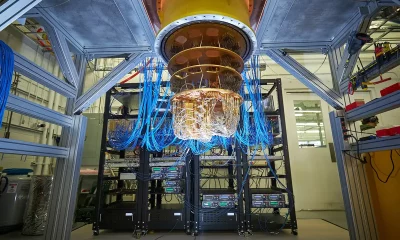NewsBeat
About 1,000 North Koreans killed fighting Ukraine in Kursk, officials say

Western officials have told the BBC that North Korean troops have already suffered nearly 40% casualties in the fighting in Russia’s western Kursk region, in just three months.
The officials, who spoke on grounds of anonymity, said that out of the estimated 11,000 troops sent from North Korea, known as DPRK (Democratic People’s Republic of Korea), 4,000 were battle casualties.
That term comprises those killed, wounded, missing or captured. Of the 4,000, the officials said around 1,000 are believed to have been killed by mid-January.
These losses, if confirmed, are unsustainable by the North Koreans.
It is not clear where the wounded are being treated, nor even when and to what extent they will be replaced.
But the figures point to an extraordinarily high cost being incurred by President Vladimir Putin’s ally, akin Kim Jong Un, as he seeks to help him evict Ukrainian forces from Russia ahead of any possible ceasefire negotiations later in the year.
Ukraine launched a lightning thrust into the Russian oblast of Kursk last August, taking Russian border guards by surprise.
The government in Kyiv made it clear at the time that it had no intention of holding onto the territory seized, merely to use it as a bargaining chip in future peace negotiations.
Ukraine’s early gains in Kursk have since been steadily pushed back, partly due to the arrival in Russia of the North Koreans in October.
But Ukraine still retains several hundred square kilometres of Russian territory and is inflicting huge losses on its enemy.
The North Korean troops, reportedly from an “elite” unit called the Storm Corps, appear to have been thrown into the fight with comparatively little training or protection.
“These are barely trained troops led by Russian officers who they don’t understand,” says the former British Army tank commander, Col Hamish de Bretton-Gordon.
“Quite frankly they don’t stand a chance. They are being thrown into the meat grinder with little chance of survival. They are cannon fodder, and the Russian officers care even less for them than they do for their own men.”
Reports attributed to South Korean intelligence say the North Koreans are unprepared for the realities of modern warfare, and appear especially vulnerable to being targeted by Ukrainian First-Person-View (FPV) drones, a weapon that has been a familiar part of the battle space further south in Ukraine’s Donbas region for years now.
Despite this, Ukraine’s top military commander Gen Oleksandr Syrskyi warned earlier this week that North Korean soldiers were posing a significant problem for Ukrainian fighters on the front line.
“They are numerous. An additional 11,000-12,000 highly motivated and well-prepared soldiers who are conducting offensive actions. They operate based on Soviet tactics. They act in platoons, companies. They rely on their numbers,” the general told Ukraine’s TSN Tyzhden news programme.
Politics
POLL OF THE DAY: As the economy struggles


UK public borrowing surged to £17.8billion in December, marking the highest December borrowing in four years.
The figure came in 25 per cent above economist predictions, according to data released by the Office for National Statistics (ONS).
The unexpected increase in borrowing costs has raised concerns about the state of public finances, despite Chancellor Rachel Reeves maintaining confidence in the country’s financial health following the October budget.
The significant rise was primarily attributed to high debt interest costs and a one-off military housing purchase. The December borrowing figure represents a £10.1billion increase compared to the same period last year.
Economists had forecast public sector net borrowing would reach £14.1billion for the month.
The market pressures come amid recent financial turbulence, with the pound falling to a nine-month low against the dollar two weeks ago. UK 10-year borrowing costs have climbed above 4.8 percent.
The yield on 30-year gilts has reached 5.36 percent, its highest level since 1998.
The Chancellor’s £9.9billion fiscal headroom is at risk of being completely erased, according to economic experts.
With that in mind, as the economy struggles – Should Rachel Reeves prioritise reducing debt or economic growth? Vote in our poll and have your say by commenting below.
NewsBeat
Oxfam report: Britain should give India back its artefacts in lieu of £52trn in colonialism reparations, says historian

A historian has suggested Britain return looted artefacts to its former colonies instead of vast sums in reparations, after an Oxfam report suggested India was owed over £52 trillion.
The report suggested that Western nations commit to providing former colonies with at least £4 trillion annually in reparations and “climate debt” – a sum reflecting the costs developed economies owe poorer nations for climate change.
The report, titled Takers not Makers: The Unjust Poverty and Unearned Wealth of Colonialism, said: “Oxfam calculates that between 1765 and 1900, the richest 10 per cent in the UK extracted wealth from India alone worth US$33.8 trillion (£27.38 trillion) in today’s money.”
It added that “this would be enough to carpet the surface area of London in £50 notes almost four times over”.
The figure of $64.82 trillion (£52.58 trillion) was not calculated by the report’s authors but was attributed to two Delhi-based Indian economists, Utsa Patnaik and Prabhat Patnaik.
“Reparations must be made to those who were brutally enslaved and colonised,” the report read. “Our modern-day colonial economic system must be made radically more equal to end poverty. The cost should be borne by the richest people who benefit the most.”
Rana Safvi, a leading Indian historian and author, questioned the practicality and implications of such large sums in monetary reparations. She told The Independent that there were concerns about the complexity of addressing historical wrongs and the risk of opening a Pandora’s box, considering the vast scale of past injustices worldwide.
“What they can actually return are the artefacts, the jewellery, the documents, the manuscripts, the paintings, all that has been looted from India should definitely be sent back,” she said. “Not just India, you know – all these museums all over the Western world are populated by things from Africa and Asia only.
“While the return of money may be chasing a fool’s dream, repatriating artefacts and treasures illegally taken from India is necessary and achievable.”
The Oxfam report drew sharp criticism from some other academics. Prof Lawrence Goldman, of St Peter’s College, Oxford, was quoted as saying by The Telegraph: “Oxfam depends on public trust in the accuracy of information it provides. Producing bogus history warped by ideology hardly encourages anyone to dig deep in their pockets and send them cash.”
He added: “There’s a reverse argument in which Indians should pay Britain for saving them from becoming part of the French overseas empire in the 18th century or being swallowed by Tsarist Russia in the 19th century, or being overrun by the Japanese in the 20th century, all of which were real threats.
“But arguments of this type, in which history becomes ammunition for a political assault, are worthless.”
An Oxfam spokesperson told The Independent: “Putting an exact figure on the cost of colonialism to countries like India will always be a source of debate. We believe the figure we quoted in the report is a reasonable one, but other estimates can be made.
“However, very few would dispute that Britain derived a significant financial benefit from its empire and its colonisation of India in particular, and that these benefits accrued mainly to the richest people in the UK at the time.”
The report said that in 2024 billionaire wealth grew three times faster than in 2023, with five trillionaires projected within a decade. Meanwhile, crises of economy, climate, and conflict mean the “number of people living in poverty has barely changed since 1990”.
Most billionaire wealth – 60 per cent – stems from inheritance, corruption, or monopoly power, Oxfam said. It said that the world’s inequality has roots in colonialism, which enriched the wealthy while exploiting marginalised groups, including women and racialised communities.
“This exploitation of people worldwide drove an explosion of wealth for rich people in rich countries and contributed to deep inequality in the Global South, often favouring an elite few at the expense of the many.”
The “Takers not Makers” report said this legacy persists, as wealth continued to flow from the Global South to the Global North at a rate of $30m (£24.5m) per hour. It noted that to address this imbalance, reparations for colonial exploitation and systemic reforms targeting the wealthiest are necessary to achieve equality and end poverty.
“Reparations to the victims must be made to ensure restitution, provide satisfaction, compensate for damages incurred, ensure rehabilitation and prevent future abuses,” it said.
An Oxfam spokesperson added: “Along with many other scholars and activists, we believe it is reasonable to ask the richest countries to pay reparations for the harm done by colonialism. It’s not about asking individuals who are already struggling to pay for the wrongs of the past, reparations should be financed by those who continue to profit from these systems, such as the wealthiest individuals and corporations, not ordinary people.”
“We are not saying that colonialism is the sole driver of inequality; other causes include monopoly power and cronyism and corruption. But colonialism, both historically and in the modern day is a crucial factor that must be addressed to create a more equitable future for all,” they said.
Oxfam International executive director, Amitabh Behar, said: “The capture of our global economy by a privileged few has reached heights once considered unimaginable. The failure to stop billionaires is now spawning soon-to-be trillionaires. Not only has the rate of billionaire wealth accumulation accelerated – by three times – but so too has their power.”
He added: “The crown jewel of this oligarchy is a billionaire president, backed and bought by the world’s richest man Elon Musk, running the world’s largest economy. We present this report as a stark wake up-call that ordinary people the world over are being crushed by the enormous wealth of a tiny few.”
Oxfam also suggested that governments cap top incomes, tax the rich, abolish tax havens, and reverse wealth flows from the Global South. “Inheritance needs to be taxed to dismantle the new aristocracy,” it said.
“Former colonial powers must also confront the lasting harm caused by their colonial rule, offer formal apologies, and provide reparations to affected communities,” the statement said.
NewsBeat
Sealed with a kiss: Same sex couples in Thailand celebrate equal marriage rights | World News

Hundreds of same-sex couples have been tying the knot in Thailand today as it becomes by far the largest nation in Asia to allow equal marriage and the first in South East Asia.
A mass LGBTQ wedding at a shopping mall in Bangkok saw hundreds of marriage registrations as the law came into effect. It marked the culmination of years of campaigning and thwarted attempts to pass equal marriage laws.
Porsch Apiwatsayree and Arm Panatkool have been together for 17 years, but first got engaged 11 years ago.
“Personally, I think it marks the beginning of equality in Thailand and it also, in a way, inspired people to see that love is normal,”Porsch said, holding his hand on his heart. “Every love is the same, every love is the same inside.”
Thailand’s same-sex marriage bill was passed in an historic parliamentary vote last June, making Thailand the third country in Asia to do so after Taiwan and Nepal.
Thailand ranks highly on global assessments of LGBTQ legal conditions and public attitudes. It’s very different from many of its neighbours where most nations oppose gay rights. Opinion polls have also shown overwhelming public support for equal marriage.
But the kingdom remains a conservative Buddhist society with a largely patriarchal family structure.
‘Love is just love’
Porsch and Arm still believe it has some way to go to ensure tolerance translates to full acceptance.
“We have to wait and see because even the law has approved that love is the same. We need more and more acceptance,” Porsch said.
His own wedding to Arm was celebrated in the grounds of a luxurious new shopping centre. The families of both grooms played a huge part in the ceremony, lining up to face each other in a humorous and moving Thai custom of call and response between each party.
“What I feel now is the closeness between people and families,” said Porsch.
“Love is just love,” Arm added, with a beaming smile.
NewsBeat
Urgent supermarket recall of cough syrups in middle of flu season

Supermarkets have issued an urgent recall of batches of cough syrup which they fear may have been contaminated.
One customer found foreign material in their medicine sparking the move with users urged to check bottles going back as far as September 2022.
The notice applies to certain batches of Tesco Health Dry Cough Relief 200ml, Asda Strong Dry Tickly Cough 200ml, Almus Dry Cough Relief and Bells Dual Action Dry Cough.
A UKHRSA spokesman said: “Bells Healthcare is recalling the listed batches of dextromethorphan hydrobromide BP containing products as a precautionary measure, due to foreign material detected in some bottles.
“The contamination was identified by a single customer complaint and the investigation and analysis remains ongoing. Bells Healthcare is taking precautionary action to recall the potentially impacted batches at Retail, Pharmacy and Wholesaler level and this issue may impact a number of different liveries, as listed in this notification.”
Retailers were warned to stop supplying the listed batches immediately and quarantine all remaining stock and return it.
Patients were told to be vigilant for any visible contamination and contact a healthcare professional if they have any concerns.
The notice added: “Patients who experience adverse reactions or have any questions about the medication, should seek medical attention. Any suspected adverse reactions should also be reported via the MHRA Yellow Card scheme.’
The recall came after Lidl issued an urgent recall of infected cheddar cheese over fears it can cause flu-like symptoms and severe infections to babies, the elderly and pregnant women.

Some Deluxe Sriracha Cheddar Cheese Wedges, sold in branches of the budget supermarket in Northern Ireland, were found to contain a dangerous bacteria called Listeria monocytogenes.
The batches of the spicy cheese being recalled have a best before date of May 5, Lidl said in posters being put up in affected stores.
NewsBeat
Waitrose to bring back free perk that had shoppers queuing around the corner

Waitrose has heard the calls from their loyal customers and is set to bring back free hot drinks for shoppers – even if they do not buy anything in store.
The upmarket supermarket has told members of its loyalty scheme that from 27 January, they can get one complimentary drink per day if they use a reusable cup.
The perk – which entitles customers to a free americano, cappuccino, latte, or tea – was first introduced in 2013.
Four years later, the terms changed to only allow customers who had shopped in store to bag a free drink. The scheme was completely scrapped during the pandemic but was slowly being reintroduced by Dame Sharon White, the former chair of the John Lewis Partnership.
A spokesperson for Waitrose said: “Some of our members like to have their free coffee before or during their shop, rather than afterwards, so we are just offering a bit of flexibility in response to customer feedback.”
“In practice, lots of customers do this already, so this is just a formality as part of updated T&Cs.”

To claim from a free drink from a store’s self-service machine, you must bring your own cup and be a MyWaitrose member – which you can sign up for free for online.
An email sent to members of its loyalty scheme read: “You’ll be able to get your free hot drink without buying anything in store first. Don’t forget your reusable cup!”
The move comes after it was revealed in November that high-street rival M&S had overtaken Waitrose in market share for the first time outside the Christmas period.
Jason Tarry, a former Tesco chief executive, took charge as new Waitrose chairman last autumn and is perhaps trying to regain ground with middle-class shoppers.

When the free drink perk was first introduced, the perk drew the attention of politicians including from the then Labour shadow communities minister, Andy Sawford, who asked MPs to write to the firm in 2014.
He believed the scheme would take away from small firms and “further destroy the British high street”.
Waitrose also offers free hot drinks to members of the police in what the company said was s part of an initiative to cut down on shoplifting”.
When it was introduced in August 2023, West Mercia Police Federation secretary Pete Nightingale said: “It makes sense from a business perspective because any police presence is bound to have an impact – either as a reassurance for shoppers or a deterrent for shoplifters.”
NewsBeat
Bloc may consider UK joining pan-Europe customs area

The new European Union trade chief responsible for post-Brexit negotiations has told the BBC that a “pan-European [customs] area is something we could consider” as part of “reset” discussions between the UK and EU.
Maros Sefcovic was referring to the idea, backed by some UK business groups, of Britain joining the Pan-Euro-Mediterranean Convention (PEM).
The PEM allows manufacturers to use parts or ingredients from dozens of countries, from Iceland to Turkey, in tariff-free trade.
The previous Conservative government chose not to pursue PEM as part of its post-Brexit trade deal, but some businesses say it will help Britain rejoin complex supply chains that have been hit by customs barriers.
Speaking at the World Economic Forum in Davos, Mr Sefcovic said the idea has not been “precisely formulated” by London yet and the “ball is in the UK’s court”.
The BBC understands that the UK government has begun consultations with business over the benefits of the PEM plan that could help cut red tape and improve trade. No final decision has been made yet.
Mr Sefcovic also said that a full-scale veterinary agreement that helped reduce frictions on farm and food trade would also require review.
The EU-UK fisheries deal is also due to expire next year. “A solution for fisheries is very important for the EU, again, we communicated this on multiple occasions”.
Single market treatment for UK food and farm exports would mean “we would have to have the same rules and we have to upgrade them at the same time, we call it dynamic alignment”.
Mr Sefcovic also said he was surprised that the European Commission’s offer on youth exchanges had been “spun”. “It’s not freedom of movement. It’s a bridge-building proposal.
“We do not want to look like the demanders here, because we believe this is good for the UK,” he said
The trade commissioner said UK-EU relations were “definitely” in a better place and his British counterpart Nick Thomas-Symonds was “on speed dial”.
Prime Minister Sir Keir Starmer will attend a defence and security focused EU summit next month.
As well as relations with the UK, Mr Sefcovic acknowledged that the EU needed to be “extremely cautious and responsible” in addressing trade with the Trump administration in Washington but said he was willing to negotiate.
He added that while the EU did have a surplus in goods such as cars, the US had a surplus in services
NewsBeat
A lost song from Tina Turner’s Private Dancer has been rediscovered

Music Correspondent
 EPA
EPAA song recorded for Tina Turner’s blockbuster album Private Dancer, that was presumed lost, has been rediscovered and will receive its first play on BBC Radio 2 later.
Hot For You, Baby, was cut at Capitol Studios in Hollywood and originally intended to be an album track.
But it was ultimately jettisoned in favour of era-defining pop hits such What’s Love Got To Do With It, Better Be Good To Me and the album’s title track.
Presumed missing, the master tape was recently rediscovered as her record label compiled a 40th anniversary re-release of Private Dancer.
An up-tempo rocker, full of showboating guitar chords and an extremely 1980s cowbell, Hot For You, Baby is a prime example of Turner’s raspy, physical style of soul.
The track will receive its first play on the Radio 2 Breakfast Show on Thursday, between 08:30 and 09:00 GMT.
Produced by John Grant, the record executive who masterminded her mid-career comeback, it was written by Australian musicians George Young and Harry Vanda.
It had already been recorded once by Scottish-Australian singer John Paul Young, the voice behind disco classic Love Is In The Air.
However, his version largely flew under the radar when it was released in 1979.
 PA Media
PA MediaPrivate Dancer, released in May 1984, launched an unprecedented second act in Tina Turner’s career.
She had escaped an abusive marriage to musician Ike Turner at the end of the 1970s, but the divorce left her penniless, living off food stamps and playing ill-conceived cabaret shows to pay her debts.
The music industry had largely written her off – but in England, where pop was in thrall to American R&B, she still had some heavyweight fans.
In 1981, Rod Stewart invited Turner to play with him on Saturday Night Live; and the Rolling Stones asked her to be part of their US tour. More importantly, perhaps, David Bowie told Capitol Records that Turner was his favourite singer.
A landmark album
But the turning point came when she hooked up with British producers Martyn Ware and Ian Craig Marsh, of the band Heaven 17, to record a synth-pop version of the Temptations’ 1970 hit Ball of Confusion.
A huge hit in Europe, its success persuaded Capitol to let her record an album, but they hardly threw their weight behind it.
The budget only paid for two weeks in the studio, and many of the songs Turner recorded were other artists’ cast-offs (both Cliff Richard and Bucks Fizz had turned down What’s Love Got To Do With It).
But she used her time wisely – recording all but one of Private Dancer’s songs in the UK with five different British production teams.
With the country in the grips of new wave and the new romantics, Turner was steered away from raw, fiery soul that first made her famous. But somehow, her electrifying vocals were a perfect fit for the chilly, programmed grooves she was given.
“Turner seems to completely understand the touch that each of these songs needed,” wrote Debby Miller, in a contemporaneous review of Private Dancer for Rolling Stone magazine.
In the New York Times, Stephen Holden described the record as “a landmark, not only in the career of the 45-year-old singer, who has been recording since the late 1950s, but in the evolution of pop-soul music itself”.
The album went on to sell more than 10 million copies, and earned three Grammys, including record of the year for What’s Love Got To Do With It.
Turner also performed the song on the live TV broadcast, wowing audiences with her vocals despite fighting a bad case of the flu.
A support slot on Lionel Richie’s US tour in 1984 reminded audiences of her ability to tear the roof off any venue she set foot in.
By 1985, Turner was one of the world’s biggest acts in an era of stadium superstars like Michael Jackson, Madonna and Prince.
 Getty Images
Getty ImagesThe decision to withhold Hot For You, Baby from the original tracklist of Private Dancer makes sense. It sounds a little cheesy next to the sultry, sophisticated material that eventually populated the record.
But fans will welcome the chance to hear Turner let rip, back in her prime, with a promise to “love you all night long”.
Mark Goodier, who is currently covering the Radio 2 breakfast show, said: “To have something new to hear from Tina Turner is a treat for fans of all generations and a reminder of her unique talent.
“I’m lucky enough to have both interviewed Tina and seen her perform live. She was an outrageously good performer and at the same time a remarkable graceful lady, whose every note was shaped by her incredible life.”
As well as being released as a single, the track will feature on a new five-disc deluxe edition of Private Dancer, which is due for release in March.
The collection will also feature B-sides, remixes and live tracks, as well as a film of Turner playing Birmingham’s NEC Arena in March 1985, featuring guest appearances by David Bowie and Bryan Adams.
Turner died in 2023 at the age of 83. No cause of death was given, but she was known to be struggling with a kidney disease, intestinal cancer and other illnesses.
NewsBeat
Search for suspect after ‘serious assault’ in Plymouth

Police in Plymouth say they are searching for a suspect following a “serious assault” in the West Hoe area of the city.
Devon and Cornwall Police said its officers were called at 20:55 GMT on Wednesday evening after a person was found seriously injured on West Hoe Road. They were treated by paramedics at the scene before being taken to Derriford Hospital.
The victim and their assailant are believed to know each other, the force added.
Detectives are appealing for anyone with information to contact them.
Det Ch Insp Dave Pebworth said there is a large police presence in the area and enquiries are continuing with officers carrying out a search for the suspect.
“We believe this is an isolated incident and there is no immediate threat to the wider public,” Mr Pebworth said in a statement.
“We would ask members of the public to please stay away from the West Hoe area of the city while we continue our investigation,” he added.
NewsBeat
Ukrainian comedians cope with war through humour

BBC Monitoring Russia editor
 Anton Tymoshenko/Underground Standup
Anton Tymoshenko/Underground StandupOn 14 October 2023, an unusual event was held in Ukraine’s most prestigious venue, Palace Ukraine in Kyiv.
Anton Tymoshenko became the first Ukrainian stand-up comedian to give a solo performance there.
“I grew up in a village with fewer people than Palace Ukraine can hold,” he said after the concert. “So many people had told me: It’s not going to happen… stand-up comedy has not reached that level.”
It has now, to a large extent because of the full-scale invasion launched by Russia.
The invasion turned many Ukrainians away from the previously popular and lavishly promoted Russian acts and triggered a renewed interest in Ukrainian culture.
Key Ukrainian comedians say they are now making jokes to help the public deal with the grim reality of war and also help the army by raising funds.
“Stand-up comedy is a budget version of psychotherapy,” Anton Tymoshenko tells the BBC.
“I like to relieve social tension with my jokes. When that happens, that’s the best thing.”
Another popular performer, Nastya Zukhvala, says Russia’s full-scale invasion in February gave stand-up comedy in Ukraine “a boost,” albeit for darker reasons.
“The demand for comedy looks totally natural to me now because comedy supports and unites.
“It can also make reality look less catastrophic. It is a tool which can help us process this stream of depressing information,” she tells me.
“To stay optimistic or even sane, we’ve got no other choice.”
 Anhelina Hlukhova
Anhelina HlukhovaSo what are the jokes that are making Ukrainians laugh?
This kind of humour is grim, says comedian Hanna Kochehura, but making fun of the danger makes it easier to cope with.
“It looks even darker from abroad, and it’s clear why. Anyone who’s in Ukraine knows that there are no safe places here,” she says.
“You never know if this air raid is going to be your last. You don’t know if a Shahed drone is going to target your house or your family’s house.
“Naturally, all our themes are related to the war. Because it’s our life now. Stand-up comedy is a frank genre where comedians speak about their own experiences or thoughts,” Ms Kochehura says.
Here’s an example – a joke from Anton Tymoshenko’s performance at Palace Ukraine:
“I never worried about a nuclear attack because I know it would mean death for rich residents of Kyiv. I live on the outskirts – but the nukes will hit central parts. Before fallout reaches me, it will have to make two changes on the metro.
“More realistically, I’ll get killed by Iranian Shahed drones. The sad thing is – did you hear the noise they make? They sound very demotivating, like the cheapest kind of death.”
“People can laugh at the news,” Anton tells me.
“If we’re not allowed to use [Western] missiles against targets in Russia — yes, that is funny because it is absurd. I build upon this absurd fact, and it becomes funny.
“Of course, Ukrainians find it funny.”
Western allies were initially reluctant to allow Ukraine to use their missiles against targets in Russia for fear of escalation. But the permission was granted after months of pleading by Kyiv: first shorter-range weapons in May 2024, then long-range missiles in November.
 Underground Standup
Underground StandupJoking about the war is fraught with pitfalls.
Anton Tymoshenko says he is trying not to “trigger” his audiences or add to the trauma from which they may already be suffering.
“Stand-up comedy in wartime is the most difficult type. Making jokes without offending anyone is possible to do, but that would be like joking in a vacuum,” he says.
But, it is usually possible to see where the line lies according to Nastya Zukhvala:
“I feel what other Ukrainians feel. If I find something sad or tragic, I don’t see any need to turn it into stand-up comedy.”
There’s also a very practical side to stand-up comedy in Ukraine – helping its army.
“Almost all of the comedians I know have been helping the armed forces. All of us are involved in raising funds [for the Ukrainian army]. We hold charity shows and many perform in front of the military,” says Hanna Kochehura.
Some, like Nastya Zukhvala’s husband Serhiy Lipko, a comedian himself, are in the army.
“Culture, humour or psychology – that’s all fine and well, but everything must be of practical use to the military. When so many missiles are on the way to hit you, you’re not as interested in talking about art alone,” says Mr Tymoshenko.
“My main task is holding concerts so I can raise funds for them.”
He says he has donated more than 30m hryvnyas (£580,000; $710,000) since the start of the full-scale invasion in February 2022.
Politics
ABC The View ‘hypocrisy’ row explodes as panel defends Biden pardons while Trump’s branded ‘spineless’

The hosts of ABC’s The View have sparked outrage and claims of “hypocrisy” as they discussed the recent pardons issued by President Donald Trump and former President Joe Biden.
Tuesday’s episode of the US talk show was hosted by comedian Joy Behar, 82, lawyer Sunny Hostin, 56, journalist Sara Haines, 47, political strategist Alyssa Farah Griffin, 35 and TV personality Ana Navarro, 53.
The segment was prompted by President Trump’s move to pardon some 1,500 January 6 rioters as part of a flurry of executive orders signed immediately as he retook office.
Trump gave a “full pardon” to those jailed following the violent disorder in the last days of his first presidency, who he described as “hostages” of the previous administration.
As he signed the order, the president raised a complaint about former President Biden’s choice to issue blanket pre-emptive pardons for his family and members of the January 6 committee, including Dr Anthony Fauci and General Mark Milley, who had been investigating Trump.
“I was surprised that President Biden would go and pardon his whole family because that makes him look very guilty… and how about this J6 committee, why is he pardoning them? They were guilty as hell, they rigged it. It was a rigged deal,” he said to journalists.

Trump pardoned 1500 January 6 rioters amid a flurry of executive orders
Getty
“So, in Trump’s world the lawmakers trying to save democracy are ‘thugs’ and the lawbreakers are ‘hostages,” Behar said incredulously as she opened the floor to debate.
Also picking up on Trump’s use of the term hostages, Haines called the move “the biggest middle finger he could give the entire country out of all of his options.”
Alyssa Farah Griffin, who had worked as a communications director in Trump’s previous administration, slammed his pardons as “dangerous and reckless.”
While she praised Biden’s pardoning of Fauci and Milley, Griffin attempted to provide balance as she criticised Biden’s decision to extend the immunity to his family, saying his choices “floored her”.

Behar and her panel pulled no punches in criticising Trump
ABC
She explained it set a “dangerous precedent” for futurepresidents to abuse, adding: “I think it was disgraceful, and it’ll harm his legacy.”
The comment set the studio alight, with a volcanic Navarro furiously hitting back and defending the Democrat by arguing: “I think comparing Biden’s pardons to Trump’s is like comparing apples to Volkswagens.”
The audience clapped and cheered as she blasted Republicans who were not objecting to Trump’s pardons as having “absolutely no spine.”
“Nobody who stood up and condemned that and is today silent after those pardons should be able to look at themselves in the mirror because you have no morals,” she slammed.
Defending Biden, she added: “Joe Biden’s family and the people he pardoned have not actually committed any crimes. He is trying to prevent them spending the rest of their lives fighting the government.”
While not part of the most recent moves, the former president did issue an unconditional pardon to his son Hunter, who had pleaded guilty to tax charges in September 2023 – despite previously pledging not to.
Nevertheless, Hostin agreed, stating that she “was not offended by Biden pardoning his family.”
“We’ve already had a Trump presidency, we know this administration will be a vengeful one, we know this is a vengeful man.
“If I could protect me and mine, I would do that. SoI think we need to Joe Biden some grace,” she declared.
On Trump’s pardons, she said furiously: “He ran on this, ‘I’m going to be a law-and-order president,’ which a lot of the Republican Party runs on, so I think it’s really disgraceful that he would do that.”
LATEST DEVELOPMENTS:

The View panel were slammed as ‘”hypocrites” online for their comments
ABC
The debate sparked a huge response online, with some branding The View panel as “hypocrites” and “disgusting” after the majority defended Biden’s pardons while dismantling Trump’s.
“And here we have it: these women praise Biden for pardoning his family… and in return, condemn Trump for doing the same f*****g thing by pardoning the January 6th rioters. These women are f*****g insane. #TheView,” one slammed.
Another raged: “The same day Biden pardoned his entire family and the j6 committee. Something he said he wouldn’t do. Actually STFU,”
“This show is a boatload full of angry, disgruntled, downright mean women who hate love,” a third wrote disparagingly.
“This is absolutely DISGUSTING!!!” a fourth wrote in response to the clip while another simply raged: “Such hypocrisy.” (sic)
-

 Fashion8 years ago
Fashion8 years agoThese ’90s fashion trends are making a comeback in 2025
-

 Entertainment8 years ago
Entertainment8 years agoThe Season 9 ‘ Game of Thrones’ is here.
-

 Fashion8 years ago
Fashion8 years ago9 spring/summer 2025 fashion trends to know for next season
-

 Entertainment8 years ago
Entertainment8 years agoThe old and New Edition cast comes together to perform You’re Not My Kind of Girl.
-

 Sports8 years ago
Sports8 years agoEthical Hacker: “I’ll Show You Why Google Has Just Shut Down Their Quantum Chip”
-
Business8 years ago
Uber and Lyft are finally available in all of New York State
-
Entertainment8 years ago
Disney’s live-action Aladdin finally finds its stars
-
Sports8 years ago
Steph Curry finally got the contract he deserves from the Warriors
-
Entertainment8 years ago
Mod turns ‘Counter-Strike’ into a ‘Tekken’ clone with fighting chickens
-
Fashion8 years ago
Your comprehensive guide to this fall’s biggest trends










You must be logged in to post a comment Login